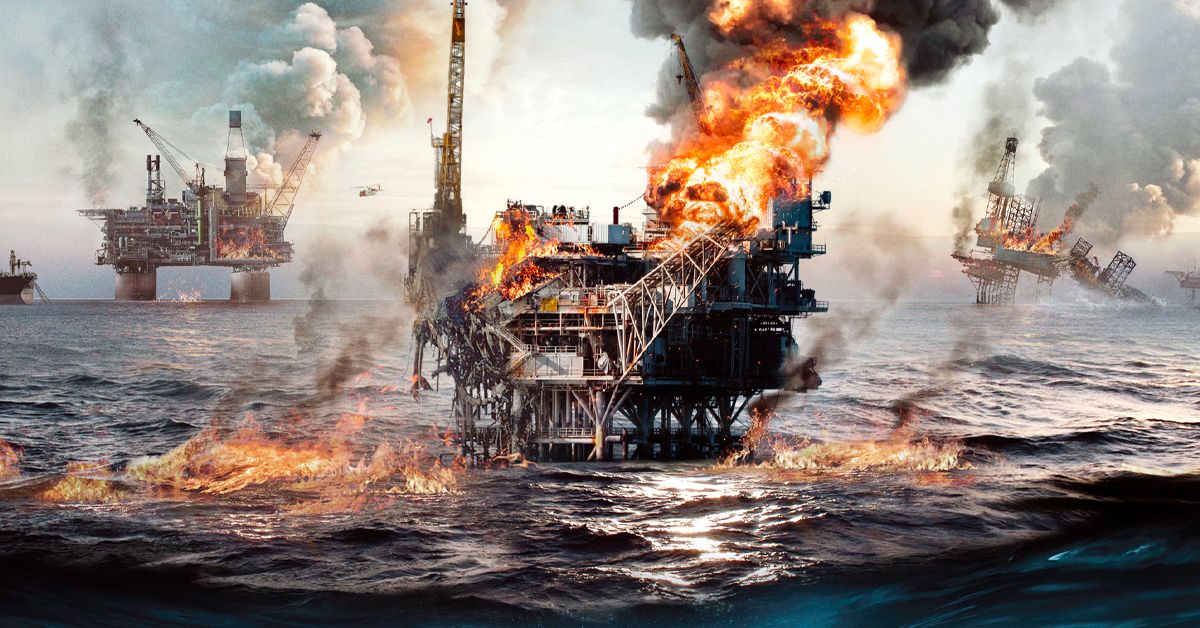The production team behind The Wave and The Quake target oil production in another well-made, but predictable Norwegian disaster epic. The Burning Sea follows a heroic robotics engineer as she fights to save her trapped boyfriend. The film explores how rampant greed eventually leads to tragedy. Drilling platforms, like British Petroleum’s infamous Deepwater Horizon, become environmental catastrophes when they fail. The Burning Sea posits a worst-case scenario that is entirely believable.
Kristine Kujah Thorp stars as Sofia Hartmann. She and her colleague, Arthur (Rolf Kristian Larsen), operate eel-like submersible robots for underwater exploration. Sofia has fallen in love with Stian (Henrik Bjelland), who works on an oil rig in the North Sea. Sofia and Arthur are ordered into quick action when a gas explosion cripples a nearby rig. They’re placed under the command of Wlliam Lie (Bjørn Floberg). He spearheads the response for the Norwegian government.
Sofia guides the robot through a dark maze of wreckage and bodies. They make a hopeful discovery but are forced to retreat. A shaken Sofia reviews footage of the incident with Arthur. They find that the cause of the explosion was not a random incident. Something much more dangerous is happening. Sofia brings their evidence to William. He alerts the energy minister (Christoffer Staib) of a possible crisis that could endanger all the North Sea oil platforms. Then trigger an event that would destroy the Norwegian coastline and contaminate Europe.
The Burning Sea and Realistic Tension
The Burning Sea thankfully lacks the hyperbolic reactions of Hollywood disaster films. The filmmakers do a good job of establishing realistic tension. The characters react accordingly as the crisis escalates. Different aspects of the military and civilian government come into play as needed. Many key scenes take place in a control center where scientists and officials interpret computer data. This may seem like submarine warfare but depicts an accurate and methodical response. The film then kicks into high gear with the visual effects-driven scenes on the rig.
Sofia’s relationship with Stian and his son (Nils Elias Olsen) becomes contrived. It’s no surprise that of the hundreds of workers on multiple oil platforms over a vast distance, Stian will be the one that needs saving. Sofia, of course, has to fight nonsensical bureaucracy to rescue her man. These scenes are meant to add emotional weight. They feel obvious and somewhat sappy. I don’t want to take anything away from Kristine Kujah Thorpe’s performance. She’s a good protagonist. The script just needed to cut down on the melodrama.
The Burning Sea has a prologue that spells out the problem directly. Oil production means big money and profits. Consequences are trivial compared to cash flow. This shortsighted thinking has repeatedly resulted in environmental emergencies. Sooner or later a disaster will occur that’s not reversible. The Burning Sea is a warning and plea for responsible energy exploration. It delivers that message clearly despite the lovers in distress theatrics.
The Burning Sea has Norwegian dialogue with English subtitles. It is produced by Fantefilm in conjunction with Creative Europe Media, Nordisk Film & TV Fond. The Burning Sea, natively titled Nordsjøen, will have a VOD and theatrical release on February 25th from Magnet Releasing.

